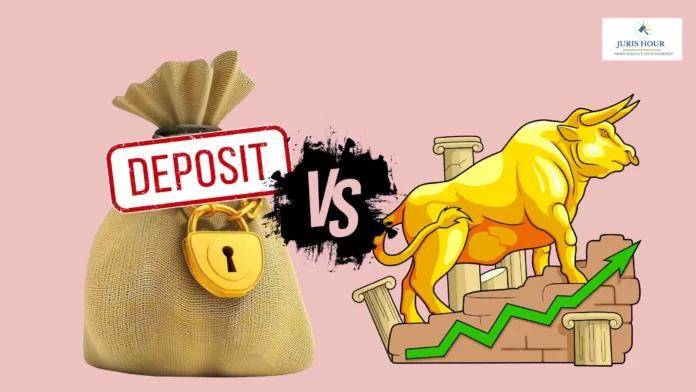In India, Fixed Deposits (FDs) and Stocks represent two contrasting forms of investment. FDs are traditionally associated with safety and guaranteed returns, while stocks are linked to higher returns and higher risk. Choosing between the two depends on factors like your financial goals, risk appetite, investment horizon, and income requirements.
This article dives deep into the comparison of FD and stock investments in the Indian context and suggests better or alternative options based on different needs.
FD vs Stocks: The Basics
| Feature | Fixed Deposit (FD) | Stocks |
| Risk | Low (almost none) | High |
| Returns | 5.5% – 8% (taxable) | Historically 10% – 15% CAGR (market-linked) |
| Liquidity | Moderate (penalty on premature withdrawal) | High (can sell anytime on exchanges) |
| Income Type | Fixed interest | Capital appreciation & dividends |
| Safety | Very safe (especially in scheduled banks) | Market risk involved |
| Taxation | Interest taxed as per slab | Capital gains taxed (varies with duration) |
Where Should You Invest in FD or Stocks in India?
Choose FDs If:
- You are risk-averse and prefer guaranteed returns.
- You need capital preservation over capital growth.
- You are retired or approaching retirement.
- You have short-term goals (less than 3 years).
- You do not want to track or manage investments actively.
Choose Stocks If:
- You have a long-term horizon (5 years or more).
- You can withstand market fluctuations.
- You aim for higher returns.
- You are willing to learn or take help managing your investments.
- You’re in a lower tax bracket or investing via tax-efficient routes.
Example:
A 30-year-old salaried individual can allocate a higher percentage to equity/stocks for wealth generation, while a 60-year-old retiree may prefer FDs for safety and predictable income.
FD vs Stocks for Long-Term Investment
Stocks Win in the Long Term
Over 10+ years, Indian equity markets (Nifty 50, Sensex) have consistently delivered average returns of 10%–15% CAGR, significantly outpacing FD returns. With compounding, this leads to wealth creation.
Example:
Investing ₹1 lakh for 10 years:
- FD at 7%: ₹1.96 lakh
- Stock at 12%: ₹3.10 lakh
Conclusion:
For long-term goals like retirement, child’s education, or buying a house, stocks (especially via mutual funds or SIPs)offer better growth.
Better Options Than FD in India
While FDs are safe, other instruments can offer better returns with acceptable risk:
| Alternative | Expected Returns | Risk Level | Ideal For |
| Debt Mutual Funds | 6%–8% | Low to Moderate | Low-risk, tax-efficient investors |
| RBI Floating Rate Bonds | 7.35% (as of 2024) | Low | Long-term stable income |
| Post Office Monthly Income Scheme (POMIS) | ~7.4% | Low | Regular income for senior citizens |
| Senior Citizen Saving Scheme (SCSS) | ~8.2% | Very Low | Senior citizens (60+) |
| Corporate Fixed Deposits | 7%–9% | Moderate (credit risk) | Higher returns seekers |
| REITs/InvITs | 6%–10% | Moderate | Passive income from real estate/infrastructure |
Short-Term Investment Options Better Than FD
For a short-term investment horizon (up to 3 years), safety and liquidity are key. Consider:
| Investment Option | Expected Return | Liquidity | Risk |
| Liquid Mutual Funds | 4%–6% | High | Very Low |
| Ultra-Short-Term Debt Funds | 5%–7% | Moderate | Low |
| Recurring Deposit (RD) | Similar to FD | Low | Very Low |
| Arbitrage Funds | 4%–6% | High | Low (tax-efficient) |
| Short-Term Bonds | 5%–7% | Moderate | Depends on rating |
Is Fixed Deposit a Good Investment in India?
Pros of FDs:
- Safety and capital protection
- Predictable income
- Useful during market volatility
- Suitable for emergency fund or elderly investors
Cons of FDs:
- Returns often don’t beat inflation
- Fully taxable interest (no indexation benefit)
- Less efficient for long-term goals
Verdict:
FDs are good for capital safety, short-term parking, and low-risk income generation, but not ideal for wealth creation or beating inflation.
Alternatives to FD for Monthly Income
If you’re looking for monthly income alternatives to FDs, consider:
| Option | Monthly Income Potential | Notes |
| SCSS (for seniors) | ₹8,200/month on ₹12 lakh | Govt-backed, quarterly payouts |
| Post Office MIS | ₹6,167/month on ₹9 lakh | Monthly payout |
| SWP from Debt Mutual Funds | Flexible | Tax-efficient with indexation |
| RBI Bonds | Semi-annual | Safe but not monthly |
| REITs/InvITs | Variable income | Market-linked but diversified |
| Corporate FD with monthly payout | 7%–9% annualized | Check credit rating |
Conclusion: What Should You Choose?
| Investment Goal | Suggested Option |
| Safety & Capital Protection | Fixed Deposits, POMIS |
| Long-Term Wealth Creation | Stocks, Equity Mutual Funds |
| Regular Monthly Income (Retirees) | SCSS, POMIS, Debt Funds (SWP) |
| Short-Term Investments | Liquid Funds, Ultra Short-Term Debt Funds |
| Better Than FD (General) | Debt Mutual Funds, RBI Bonds, Corporate FDs (carefully selected) |
Balanced Approach:
A diversified portfolio mixing FDs, equities, mutual funds, and income-oriented products helps balance risk and return based on your financial profile.
Read More: Govt. Eases Import Duties on Select Rice Varieties Effective May 1, 2025

